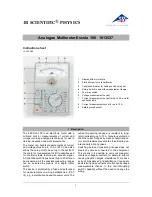
Signametrics
32
int
DMMGetdBStr(int
nDmm, LPCSTR lpszDB)
Remarks
This function is the same as the
DMMGetdB()
, with the exception that it returns a string.
See
DMMGetdB()
for more details.
Parameter
Type/Description
nDmm
int
Identifies the DMM. DMMs are numbered starting with zero.
lpszDB
LPCSTR
Points to a buffer (at least 64 characters long) to hold the
result. The return value will consist of a leading sign a floating-point,
and a ‘dB’ units specifier
Return Value
Integer string length if successful, or an error code..
Value
Meaning
Negative Value
Error code
Example
char cBuf[64]; int strLength = DMMGetdBStr(0, cBuf);
DMMGetDeviation
Description
Get percent deviation from the reading at the time relative was activated.
#include "SM2060.h"
int
DMMGetDeviation(int
nDmm, double *lpdDev)
Remarks
This function returns a double floating value that is the percent deviation relative to the
reading made just before the relative function was activated
(DMMSetRelative)
. This
function is useful in quantifying measurement errors. It can be used for bandwidth
measurements or DC evaluation, or percent variation of a device under test over
temperature. The absolute value of
lpdDev
can be used as a pass/fail window for
production. Another function effecting
DMMGetDeviation
is
DMMSetReference
.
Unlike
DMMSetRelative
, which uses the current measurement as a reference,
DMMSetReference
provides the facility to set this reference.
Parameter
Type/Description
nDmm
int
Identifies the DMM. DMMs are numbered starting with zero.
lpdDev
double *
Pointer where the deviation value is to be saved.
Return Value
Integer error code..
Value
Meaning
DMM_OKAY
Operation successfully completed.
Negative Value
Error code
Example
double error;
int status = DMMGetDeviation(0, &error);
















































